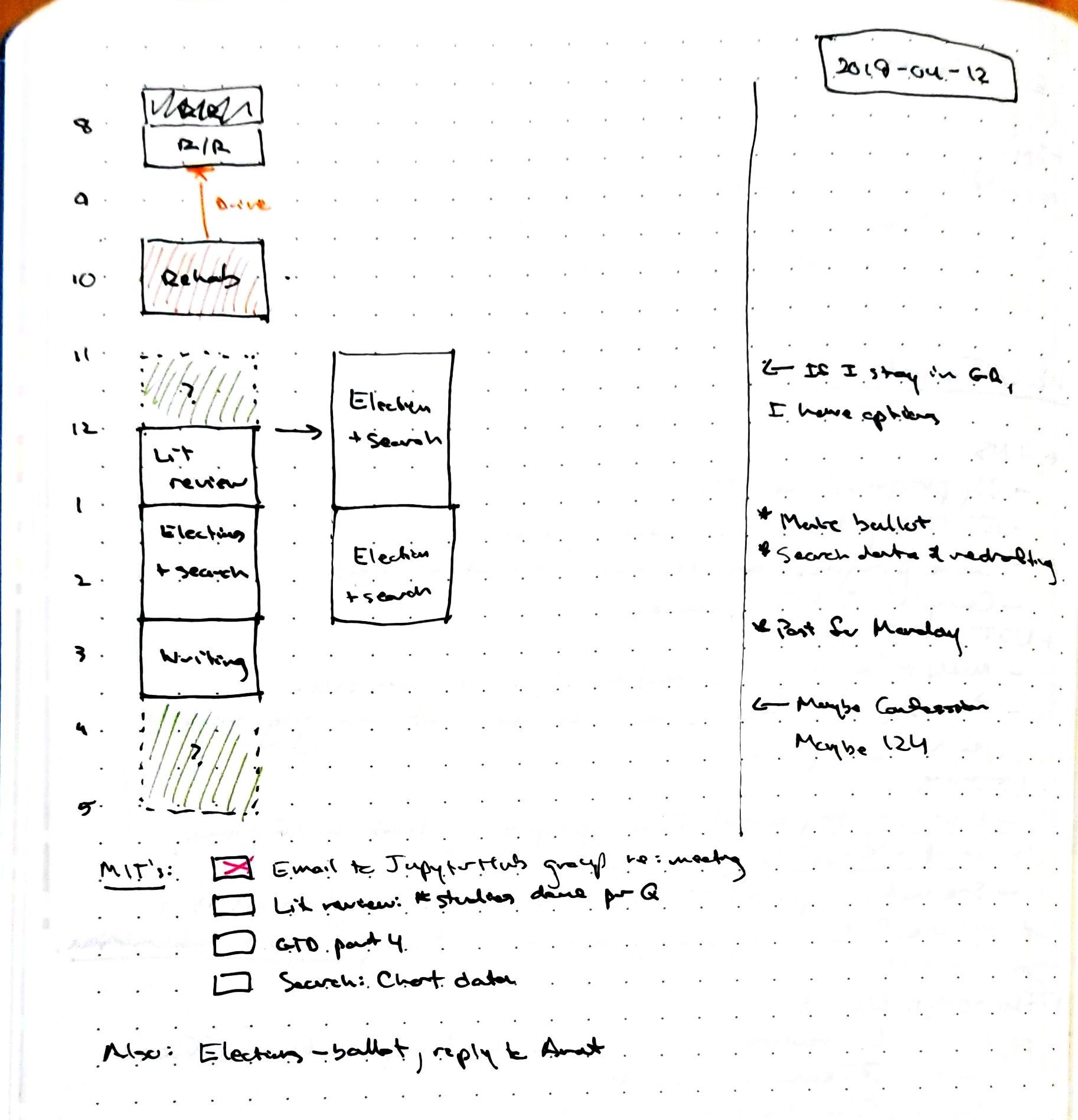Morning and afternoon rituals for peace and productivity

Rituals and routines in our daily lives are critically important anchors for how we live and work. Those of us in academia are especially familiar with the power of routines, as we follow the same academic calendar every year, and each part of that academic calendar sends distinct signals and helps mitigate the chaos of the academic workload. Rituals and routines provide structure and give us stability and a measure of peace. They are also powerful tools for getting things done. One research study, for instance, found that whether subjects completed a variety of everyday tasks was far better predicted by the frequency with which they had completed the tasks in the previous week --- i.e., by how routinized the tasks had become --- than the subjects' intentions to complete the task.
When I was on medical leave to recover from heart surgery, I was away from work for eight weeks, and homebound for six of those weeks --- by myself for seven hours a day in an empty house with nothing on the schedule. Far from being a vacation-like experience, the unstructured nature of the day quickly led to boredom and lethargy. While I needed to rest, I also didn't want to become a couch potato, so during that time I started engaging in two specific routines/rituals, one in the morning and the other in the afternoon, to bookend my days and get my mind in gear. Now that I'm back at work, I've kept these routines, and I've found them to be especially helpful in framing my life and work each day. The ideas here aren't original --- I've drawn from a number of examples, especially Cal Newport's Deep Work book --- but here's what they look like, having adapted them to my own purposes. Maybe these can be useful for you too.
The morning ritual
To get myself going in the mornings, I follow these steps:
- Wake at 5:30am. This may seem early, but it's actually not. I have three kids ages 10--15, so I'm quite used to early mornings. I have empirically verified that 5:30 is the latest I can sleep and still have some personal time in the mornings, while having enough time and space to be with the kids as they get ready for school. I'm definitely not one of those people who believe that getting up extremely early is the key to productivity; for me that's just a fast track to exhaustion.
- Process email while making coffee. I have one strong cup of black coffee each morning (cutting back on caffeine due to my heart condition) and while it brews, I use my phone to do a surface-level processing of my email. This means just deleting the stuff that should be deleted (usually about 1/3 of the email I get), routing non-actionable non-trash stuff to appropriate GMail folders (about another 1/3 of my email), and then leaving the rest for when I get into work. I've found this takes about the same amount of time as brewing my cup of coffee.
- Review my calendar and agenda for the day. At my weekly review every Sunday (another important ritual), I use timeboxing to build a schedule for each day of the week, hour by hour. Once I've retreated to my home office with my coffee, I take 3-4 minutes to review it for the day.
- Draw up an agenda in my work notebook. Having reminded myself what I'm doing for the day, I hand-draw a version of this calendar in a notebook I keep for work-related notes. Here's a sample of what that looks like:

Using the dots on the paper to make a vertical timeline from 8:00am to 5:00pm, I copy the time boxes from my Google Calendar to the paper, sometimes making decisions to change things up from the original plan if needed. Boxes for items that can't easily be moved, like doctor's appointments or faculty meetings, are shaded orange. Boxes for items that are uncertain (like a meeting that might take place at a certain time but hasn't been verified yet) or discretionary are shaded blue or green (depends on which color pen is closest). Boxes that require significant commute times (like my cardiac rehab sessions, which are an hour long and require me to drive half an hour each way) have little orange error bars extending from the box to indicate the commute time. I also have space off to the right so that when unplanned things happen and alter my calendar (which they always do), I can draw up a "version 2", "version 3", "version 4", etc. in succession in that space. For example, here on April 12 I ended up needing to appropriate more time for the "election and search" projects I was working on than I had originally planned. I also make a little notes field on the far right that reminds me what I want to do with each time box.
Why hand draw a schedule in a notebook when I already have it in Google Calendar? Mainly I just like analog tools, and drawing this out with pen and paper has a satisfying calming effect on me. It somehow also makes the upcoming events of the day a little more real.
- Determine the day's 3-4 Most Important Things (MITs). After making the schedule up, I determine the 3-4 Most Important Things (MITs) to get done today. Of all the 100+ next actions I have at any given time, these are the top 3-4 that define "success" for the day. I write these down in my notebook under the schedule (as in the picture above) and put an
MITtag on them in my GTD software. - Do spiritual reading and prayer. I don't want to get caught in the trap of focus without perspective, so I take 10-ish minutes to read something short but meaningful (my default is the Scripture readings for Mass that day) and pray about the day ahead. I'll often write something in my notebook afterwards to reflect on what I read and apply it to what's coming in the day.
- Work on one of the MITs. The previous steps usually take me about half an hour. With the remaining half hour, I work on one of my MITs. Quite often I can actually complete that MIT, sometimes even two of them, so that when I roll into the office I already have a lot of momentum for getting things done.
This entire process takes about an hour. It's often the most productive hour of my day. At that point I have to get kids prepped for school, so I stop and give them my full attention, because being fully present with family at these times is the whole point.
The afternoon ritual
It's at least as important to have a recurring, predictable ritual to end the day as it is to start the day, especially for academics, because many of us professors have come to accept the completely unacceptable notion of regularly bringing work home and doing it in the evenings and weekends. We refuse to put boundaries around when and where we'll do work, and so the work expands to fill the time and space we give it --- which is 24/7 and anywhere --- choking out any hope of having balance in our lives. Having a day-ending ritual is a powerful act of resistance against this insidious cultural norm.
Here's my afternoon "shutdown/reset" ritual, which I try to get started around 4:45 each day. A lot of this is just an application of the Getting Things Done philosophy, which you can read all about here if you're unfamiliar.
- Get all inboxes to zero. My inboxes include a physical inbox, three email accounts, my notes program, Google Keep, Google Drive, and my GTD software. Going through the clarifying process at the end of the day resets the inboxes to zero and ensures I am ending the work day knowing exactly what I need to be doing as well as what I should not be doing when I go home. Having inbox zero at the end of the day also makes it a lot easier to process email in the morning in the time it takes to brew coffee. (See this article for more on zeroing out your inbox --- if you think that's impossible, it's not.)
- Review all action items. Once the inboxes are clear, I go through my actions lists and check off any actions I've completed but forgot to mark as complete, delete or shelve any actions that aren't pertinent any more, and add any new actions that I'm reminded of while I'm doing this.
- Review all active projects. I then do the same for projects --- check through each active project in my my list of active projects, make sure I know what the next action is for each one and that this next action is in the actions lists, and review the goals and status for each one.
- Write a quick work journal entry. By this point my actions and projects are up to date. Then it's time to reflect on how things went that day. Reflection is crucial for improving practice, so I try each day to do this in a simple way. I think about three categories: "Wins" (things that went well that day), "Not Wins" (things that didn't go well; it doesn't feel right to call them "losses"), and "Lessons" (what I learned from the wins, not-wins, and events of the day). I just list out 1-3 things under each heading, taking special care to process the lessons because that's the heart of the reflective process. I'll sometimes write out what I'll do differently tomorrow to implement the lessons I've learned.
- Say, "Shutdown complete". Literally say this out loud. (This is something I learned from Deep Work.) This feels dumb and weird at first, but doing so makes the ending of the day feel a lot more real, like I have a stake in the ground and no intention to return to work that day. Once I announce to myself (and anyone listening) that my shutdown is complete, I'm done with work. I can go home, knowing that my projects and actions lists are up to date and that there are no fires to put out and no pending items I haven't thought about, and then devote 100% of my attention to family and rest until the next morning.
Do I always manage to perform these rituals as described here? Nope. This morning, for instance, I overslept and had very limited time for the morning ritual. Some days there's an incredibly full meeting schedule at work and I am going right up until 5:00pm, then have to rush home to make dinner and take a kid to some kind of practice, and so I don't get to the "afternoon" ritual until 9:00pm --- or not at all. Life can sometimes happen, and that's OK. But making rituals like these the rule and following them as consistently as one can, can provide structure and boundaries to the otherwise chaotic schedule of the day and provide some handholds for navigating a day the way you want to do it.


